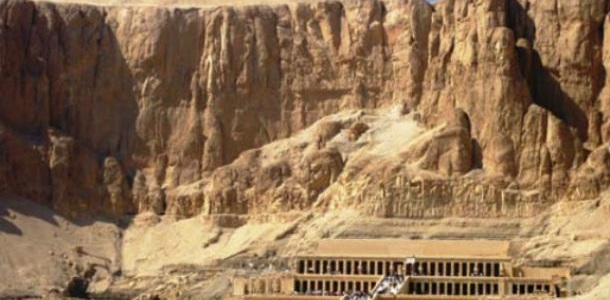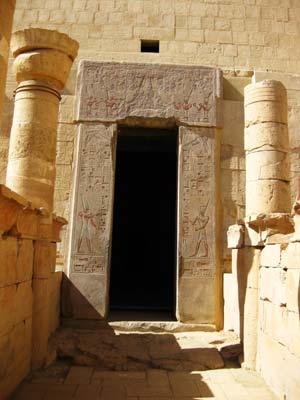
The magnificent Temple of Queen Hatshepsut, located beneath the steep cliffs at Deir el Bahari on the west bank of the Nile is considered as one of the incomparable monuments of ancient Egypt. It was built in honour of the pharaoh queen of Egypt and is today known as the Temple of Deir El-Bahri (Arabic) meaning “The Temple of the Northern Monastery”.
The remarkable feature of this renowned monument is its design which is in harmony with its natural surroundings. Far from being belittled by the massive rock face behind, the cliffs form a magnificent backdrop to this unique structure.
This Temple was built as a result of the inspiration of Queen Hatshepsut – the Queen who would be King.
Queen Hatshepsut – The enigmatic personality
There is an interesting story to the enigmatic personality that Queen Hateshepsut was.
She was the daughter of Queen Ahmose and Thutmose I, the third Pharaoh. She had two brothers and a sister. Unfortunately her siblings died before Thutmose I did, leaving Hatshepsut as the only child to succeed her father as Pharaoh. However, being a female, she was prohibited from doing so.
Mutnofret, son of Thutmose I from a wife of the royal harem, succeeded him as Thutmose II. Subsequently Hateshepsut was married to her half-brother, Thutmose II. After about 13 years on the throne Thutmose II died unexpectedly and, since they had no son, the crown passed on to Thutmose III, a son born in the royal harem. Thutmose III was still an infant and as his mother was not considered sufficiently royal to act as his regent, Queen Hatshepsut was called upon to do so. She acted as a regent for seven years and she herself was crowned as King of Egypt.
Hatshepdut did not let the fact that she was a woman stand in her way as the ruler of Egypt. She wore the badges of kingship – a royal shirt and ceremonial beard. She presided over a prosperous Egypt for more than two decades.
Queen Hatshepsut died in the 22nd year of her reign. Before she died she had two tombs built for herself. The first was in the Valley of the Kings and the second, after she became Pharaoh, was in the Taker Zeid Valley, south of Deir el Bahri and overlooking the Valley of the Kings. Strangely her body was found in neither. Whether she was poisoned so that Thutmose III might take over the throne or stabbed by her lover or killed by jealous officials or died a natural death remains a mystery.
And the tales go on.
There are two famous colonnades in the upper terrace. On the left is the Colonnade of the Expedition to Punt (Somalia). On the right is the Birth Colonnade. The Punt Colonnade commemorates an expedition ordered by Queen Hatshepsut to the Land of Punt to bring back myrrh and incense trees. The Birth Colonnade was constructed to dispel any apprehension about Hatshepsut’s right to the throne.
The Temple of Hatshepsut is indeed a monument of colossal proportions which is both imposing and awe-inspiring.
Sculptures and Paintings – A vivid tale of divine devotion
The Temple of Hatshepsut is proliferated with statues and sphinxes and recites the tale of the divine birth of a female pharaoh and the exploits of her soldiers on a trading mission to the land of Punt.
Queen Hatshepsut’s semi-divine nature is highlighted on the walls of her temple where a sequence of images and accompanying text tell the story of her divine birth. In one of the scenes you can see Queen Ahmose, mother of Hatshepsut, sitting in her boudoir where she is visited by Amon, the god of Thebes. The God tells her that she has been chosen to bear his daughter, the future king of Egypt. Another scene depicts heaven where Queen Hatshepsut is born.
Reliefs on the southern side of the middle terrace show the queen’s expedition to Punt. On the back wall are scenes of the Egyptian fleet setting sail for Punt, the reception of the Egyptian envoy and the transportation of incense trees. In the center of the long back wall the queen can be seen offering the fruits of her expedition to Amon: incense trees, wild game, cattle and gold.
The main sanctuary of the temple comprises scenes of Hatshepsut and her family, offerings made to Hathor and Hatshepsut drinking from the udder of a cow. On the back wall is another particularly beautiful relief of Hatshepsut standing between Hathor and Amon.
The Temple of Queen Hatshepsut is an exceptional monument with some incredible pieces of sculpture and images, which gives an insight into the magnificence of a bygone era. The Temple of Queen Hatshepsut, the only mortuary temple for a female pharaoh, should definitely be a must do on your visit to Egypt.
